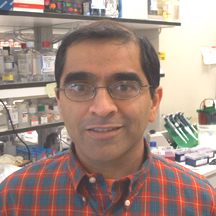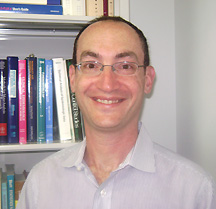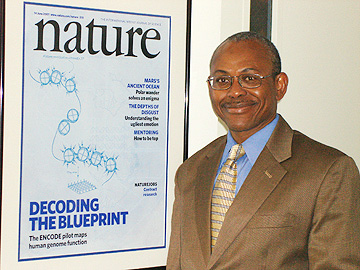
| T H E N I H C A T A L Y S T | M A R C H – A P R I L 2008 |
|
|
|
| P E O P L E |
RECENTLY
TENURED
 |
|
Sanjay
Desai
|
Sanjay A. Desai received M.D. and Ph.D. degrees from Washington University Medical School in St. Louis in 1992. After an internal medicine residency and infectious diseases fellowship at Duke University Medical Center, in Durham, N.C., he joined the Laboratory of Malaria and Vector Research, NIAID, in 1998. He is currently a senior investigator and chief of the Molecular Physiology Section, LMVR, NIAID.
My laboratory has focused on the cell biology and physiology of the malaria parasite, Plasmodium falciparum. We are particularly interested in how malaria parasites acquire nutrients and other essential solutes from the human bloodstream.
While growth inside host erythrocytes facilitates evasion of immune responses, it complicates acquisition of nutrients from serum. Many essential nutrients are not present in red cell cytosol and have inadequate host cell permeability to sustain parasite demand. This problem had been recognized for decades, but the molecular mechanisms used to overcome it were unknown. My laboratory identified two unusual ion channels that appear to resolve this dilemma.
One channel, the plasmodial surface anion channel (PSAC), is present on the infected erythrocyte membrane but absent from uninfected cells. Its unique functional properties along with two mutants we generated through in vitro selection strongly suggest PSAC is encoded by the parasite and trafficked out to the host membrane.
Striking among PSAC’s functional properties is that it permits negligible Na+ uptake despite broad permeability to needed sugars, amino acids, purines, organic cations, and some vitamins.
This selectivity profile is unprecedented among other ion channels; it is also important for parasite survival because Na+ exclusion is required to maintain infected erythrocyte osmotic stability in plasma.
We determined that a major contributor to PSAC’s solute selectivity is electrostatic repulsion of Na+ by cationic residues situated at the extracellular pore mouth. The significant permeability of organic cations indicates that additional features, presumably acting via an as-yet-unidentified selectivity filter in the pore, must also contribute to Na+ exclusion.
PSAC’s strict conservation in all plasmodia suggests it may be a target for antimalarial development. To test this hypothesis, we found high-affinity PSAC antagonists through high-throughput screening with a quantitative transmittance-based assay developed by my group. These antagonists sterilize in vitro parasite cultures.
There is also a good correlation between these antagonists’ affinity for PSAC and their parasite growth inhibitory concentrations, fulfilling a classical test of target validation in drug development. The Medicines for Malaria Venture, a Geneva-based public-private partnership that seeks to discover and develop new antimalarial drugs, has recognized PSAC as an important target and has accepted our project into their portfolio.
The second ion channel we identified is a large conductance channel on a specialized membrane, the parasitophorous vacuolar membrane, surrounding the intraerythrocytic parasite. This channel appears to provide the parasite with direct access to metabolic precursors in RBC cytosol and may also be a good drug target.
Major ongoing areas of investigation in the laboratory include 1) identification of the genes responsible for these and other parasite transport mechanisms with molecular, genetic, and biochemical approaches, 2) functional characterization of these transport proteins with the goal of understanding their structures and physiological roles, and 3) antimalarial drug discovery and development using novel, high-affinity PSAC antagonists.
 |
| Eric
Engels |
Eric Engels received his M.D. degree from Harvard Medical School in Boston in 1991. He trained in internal medicine at Brigham and Women’s Hospital, Boston, and in infectious diseases at Tufts University School of Medicine, Boston, before joining NCI in 1998 as a senior staff fellow in the Viral Epidemiology Branch. He is currently a senior investigator in that branch, recently renamed the Infections and Immunoepidemiology Branch, NCI.
As an epidemiologist in NCI’s Division of Cancer Epidemiology and Genetics, my research focuses on the role of infection, immunity, and inflammation in the etiology of cancer. This work is grounded in my long-standing clinical interest in HIV and other infectious diseases and in a keen appreciation for quantitative approaches to epidemiologic questions.
A major component of my research aims at improving our understanding of cancer among people with HIV/AIDS. This research uses data from my HIV/AIDS Cancer Match (HACM) Study, which links HIV/AIDS and cancer registry data from 13 U.S. regions to identify cancers arising in more than 630,000 HIV-infected people.
The HACM Study allows me to examine patterns of cancer incidence that have direct public health relevance. I recently used this resource to describe trends in cancer risk among people with AIDS over the course of the AIDS epidemic from 1980 to 2002. I documented substantial declines in Kaposi sarcoma and non-Hodgkin lymphoma (NHL) over time, and a steep unexpected rise in Hodgkin lymphoma risk.
My interest in cancers in transplant recipients, another immunosuppressed population, evolved from my work on HIV/AIDS. I lead a major collaboration with the Health Resources and Services Administration, which oversees the U.S. transplant network. Together we are conducting a computerized match of U.S. transplant and cancer registries.
Our Transplant Cancer Match Study will obtain population-based cancer data on approximately half of the U.S. transplant population. The coupling of data in the transplant registry regarding demographics, cancer-related exposures (for example, viral infections), and medications, with detailed information from the cancer registries, will create a unique research resource.
Having observed a remarkably high risk for lung cancer among HIV-infected people in the United States, I questioned the common assumption that frequent tobacco use entirely explains the elevation. I have now conducted several retrospective cohort studies of lung cancer among HIV-infected persons.
Using various statistical methods to adjust for the effects of tobacco, each study has demonstrated that lung cancer risk is higher in HIV-infected people than predicted from the effects of smoking alone. We are now developing epidemiologic approaches to test the hypothesis that other processes, such as inflammation, play a role in promoting lung damage among HIV-infected individuals. In several other studies, I am currently evaluating chronic Chlamydia pneumoniae infection, pulmonary scarring, and pneumonia and tuberculosis as risk factors for lung cancer.
My interest in NHL also stems from the high risk seen in people with HIV/AIDS, as well as my belief that other infections and immune-related conditions are important. Building on my prior work on the epidemiology of human herpesvirus 8 (HHV8), I described the first case of an HHV8-positive NHL in Africa. I also conducted a large retrospective cohort study of hepatitis C virus (HCV) and risk of lymphoproliferative malignancies in U.S. military veterans. This study showed an association with NHL and, for the first time, an increased risk for the related malignancy Waldenström macroglobulinemia.
Finally, my official duties include work as a physician in the Johns Hopkins Hospital HIV clinic in Baltimore, where I attend for one full day every two weeks. Most of my patients there have complex medical problems, such as HCV-related liver disease and tobacco-induced lung disease, compounded by such social problems as substance abuse, poverty, and homelessness.
It has been rewarding to follow these patients over an extended period of time and to see the beneficial effects of HIV therapy advances. This work provides the opportunity to use my clinical skills to help an underserved population, and it motivates and grounds my research activities.
 |
| Charles
Rotimi |
Charles Rotimi received his Ph.D. degree in epidemiology from the University of Alabama, Birmingham, in 1991. He did his postdoctoral work at Loma Linda (Calif.) University and Loyola University Chicago–Stritch School of Medicine in Maywood, Ill., and in 2004 became the director of the National Human Genome Center at Howard University College of Medicine in Washington. He joined NHGRI in late November 2007 as the first director of the new NIH Intramural Center for Genomics and Health Disparities.
Research activities in my laboratory are directed at understanding the patterns and determinants of common diseases in populations of the African Diaspora, with particular focus on the triangular relationship between obesity, hypertension, and type 2 diabetes (T2D).
Recent African-origin populations provide unique opportunities to study how "old" genes interact with "new" environments in the evolution of common complex diseases. Taking advantage of the huge contrast in the distribution of risk factors at the genetic and environmental levels in contemporary African populations, my lab uses genetic epidemiology and population genetics models to study the determinants of obesity, hypertension, diabetes, and associated complications.
We are particularly interested in generating data to explain phenomena such as the "thrifty genotype" hypothesis, which postulates that some genes in humans have evolved to maximize metabolic efficiency—as reflected, for instance, in lipid storage and food-searching behavior—and that in times of abundance, these genes predispose their carriers to diseases caused by excess nutritional intake, such as obesity and T2D.
My lab is leading an international team of investigators to understand how inherited factors in combination with lifestyle increase the risk of or resistance to T2D. The name of this novel project is "Africa America Diabetes Mellitus (AADM, pronounced Adam) Study." It was originally designed to identify diabetes genes in West Africa, the geographical origin of most African Americans. It has expanded to include sites in East Africa and China.
The AADM project has enrolled more than 4,800 persons with diabetes and control subjects, and it is contributing significant data to the global effort to understand the genetic basis of T2D.
In collaboration with colleagues in Iceland (deCODE Genetics), we recently identified three genes that are likely to play a major role in the risk of getting diabetes.
The first gene, called TCF7L2, is arguably the most important gene identified for diabetes to date and was identified using the genome-wide association strategy involving thousands of persons with diabetes and control subjects.
The second gene, called CDKAL1, influences insulin response. Persons who have two copies of this gene have a blunted insulin response compared with those who carry only one copy or are noncarriers.
The third gene, TCF2 (HNF1b), associated with increased prostate cancer risk, may confer protection against T2D—an important finding that may help us understand the inverse relationship previously observed between the risk of diabetes and prostate cancer and that may have prevention and treatment implications.
Research resources available through the AADM project have facilitated multiple international collaborations, including: 1) an ongoing project in Joan Marini’s lab at NICHD on the genetic basis of osteogenesis imperfecta caused by mutation in the LEPRE1 gene; 2) a genome-wide association study of hypertension in African populations in Richard Cooper’s lab at Loyola University in Chicago; 3) a study of the genetics of Bardet-Biedl syndrome in African patients—the role of novel mutations in the BBS5 gene; and 4) the population genetics of the hypervariable region of the mtDNA.
In collaboration with investigators at the Coriell Institute for Medical Research in Camden, N.J., my lab is using the Affymetrix Genome-Wide Human SNP Array 6.0 with 1.8 million genetic markers to perform the first genome-wide association scan of an African American cohort to search for genes associated with obesity, hypertension, diabetes, and the metabolic syndrome.
The more than 2,000 related and unrelated African Americans included in this study were enrolled and examined by my lab.
In collaboration with Julie Palmer of Boston University, my lab is participating in the Black Women Heart Study—a national longitudinal cohort of women assembled in 1995 to study causes of illness in black women. It includes 59,000 women aged 21–69 at baseline. My lab has been responsible for receiving, isolating, and tracking DNA samples from more than 25,000 women. This is a national resource that is making significant contribution to our understanding of major health outcomes (for example, diabetes and lupus) in women, with special focus on African American women.
I am the founding and current president of the African Society of Human Genetics (AfSHG), which was formed to engage African researchers, and other researchers interested in Africa, in genomic research.
Since its inception the society has provided a forum for African scientists and students to interact and exchange information in the field of genomic research. In collaboration with scientists from Ethiopia, the United Kingdom, and the United States, my lab is involved in a Wellcome Trust–funded project to understand the genetic basis of podoconiosis.
A model for gene-environment interactions, podoconiosis (endemic nonfilarial elephantiasis) is a geochemical disease occurring in individuals exposed to red clay soil derived from alkalic volcanic rock. One of the striking features of podoconiosis is that only a small proportion of individuals who are exposed to red clay develop disease. Investigators involved in this project met under the umbrella of the AfSHG, and I anticipate that AfSHG will provide a wonderful forum for my lab and attract minority and African students and investigators to multiple labs at NIH.
Finally, I believe that scientific activities operate within the larger context of societies and that the junction of society and science constantly has to be managed so as not to trample on the independence required for good scholarly investigation or to alienate members of societies from the scientific process.
In this
regard, my lab is interested in how scientists document and describe the nonrandom
pattern of human genetic variation and its link to disease risks in different
populations. For example, how does human genetic variation inform our understanding
of self and group identity and differential distribution of diseases? We are
directly involved in these debates and hope to inform the interpretation of
human genetic variation within the context of health disparities and group identity.
![]()